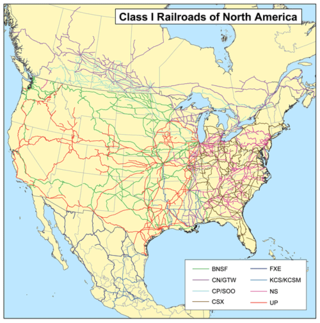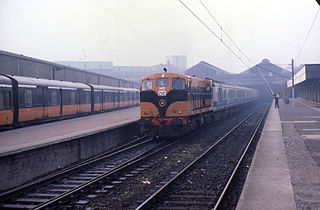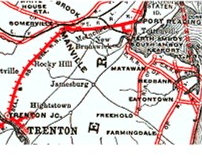
The Hepburn Act is a 1906 United States federal law that expanded the jurisdiction of the Interstate Commerce Commission (ICC) and gave it the power to set maximum railroad rates. This led to the discontinuation of free passes to loyal shippers. In addition, the ICC could view the railroads' financial records, a task simplified by standardized bookkeeping systems. For any railroad that resisted, the ICC's conditions would remain in effect until the outcome of legislation said otherwise. By the Hepburn Act, the ICC's authority was extended to cover bridges, terminals, ferries, railroad sleeping cars, express companies and oil pipelines.

The Staggers Rail Act of 1980 is a United States federal law that deregulated the American railroad industry to a significant extent, and it replaced the regulatory structure that had existed since the Interstate Commerce Act of 1887.

Railroad classes are the system by which freight railroads are designated in the United States. Railroads are assigned to Class I, II or III according to annual revenue criteria originally set by the Surface Transportation Board in 1992. With annual adjustments for inflation, the 2019 thresholds were US$504,803,294 for Class I carriers and US$40,384,263 for Class II carriers.

The Surface Transportation Board (STB) of the United States is an independent federal agency that serves as an adjudicatory board. The board was created in 1996 following the abolition of the Interstate Commerce Commission (ICC), and absorbed regulatory powers relevant to the railroad industry previously under the ICC's purview.

CSX Corporation is an American holding company focused on rail transportation and real estate in North America, among other industries. The company was established in 1980 as part of the Chessie System and Seaboard Coast Line Industries merger. The various railroads of the former Chessie System and Seaboard Coast Line Industries that are now owned by CSX Corporation were eventually merged into a single line in 1986 and it became known as CSX Transportation. CSX Corporation currently has a number of subsidiaries beyond CSX Transportation. Previously based in Richmond, Virginia after the merger, the corporation moved its headquarters to Jacksonville, Florida, in 2003. CSX is a Fortune 500 company.

A siding, in rail terminology, is a low-speed track section distinct from a running line or through route such as a main line, branch line, or spur. It may connect to through track or to other sidings at either end. Sidings often have lighter rails, meant for lower speed or less heavy traffic, and few, if any, signals. Sidings connected at both ends to a running line are commonly known as loops; those not so connected may be referred to as single-ended or dead-end sidings, or stubs.

The Pennsylvania-Reading Seashore Lines was a railroad that operated in South Jersey in the 20th century. It was created in 1933 as a joint consolidation venture between two competing railroads in the region: the Pennsylvania Railroad and the Reading Company.

Rail freight transport is the use of railroads and trains to transport cargo as opposed to human passengers.
A freight rate is a price at which a certain cargo is delivered from one point to another. The price depends on the form of the cargo, the mode of transport, the weight of the cargo, and the distance to the delivery destination. Many shipping services, especially air carriers, use dimensional weight for calculating the price, which takes into account both weight and volume of the cargo.

Shunting, in railway operations, is the process of sorting items of rolling stock into complete trains, or the reverse. In the United States this activity is known as switching.

The Mount Hood Railroad is a heritage and shortline freight railroad located in Hood River, Oregon, 60 miles (97 km) east of Portland, Oregon, United States.

The Pacific Harbor Line was formed in 1998 to take over the Harbor Belt Line (HBL). In 1998, the Alameda Corridor was nearing completion, allowing for a massive amount of railroad traffic from the largest harbors in the Western hemisphere: Port of Los Angeles and Port of Long Beach.

The Modesto and Empire Traction Company is a Class III short-line railroad operating in California's San Joaquin Valley. It is owned by the Beard Land & Investment Company; the Beard family has always owned the railroad. The Beards also created the Beard Industrial Park where the MET's customers are located. The railroad was unique in that it had operated for nearly 50 years exclusively with GE 70-ton switchers built between 1947 and 1955; however, a former Southern Pacific EMD SW1500 switcher was added to the roster as of late. The MET operates on 5 miles (8 km) of mainline track, as well as an additional 48.7 miles (78.4 km) of yard and industry track, providing switching services in the Beard Industrial Park. The MET interchanges with the Union Pacific at Modesto and with the BNSF Railway Stockton Subdivision at Empire.

The Port Reading Railroad was a railway company in the United States. It was incorporated in 1890 and completed its main line in 1892. It was controlled throughout its corporate life by the Reading Company. The Port Reading Railroad's line was conveyed to Conrail in 1976, and is today the Port Reading Secondary.

The Escanaba & Lake Superior Railroad is a Class III shortline railroad that operates 347 miles (558 km) of track in Northeastern Wisconsin and the Upper Peninsula of Michigan. Its main line runs 208 miles (335 km) from Rockland, Michigan, to Green Bay, Wisconsin, and it also owns various branch lines and out-of-service track. In 1897, the Escanaba River Company built a seven-mile (11 km) railroad from Wells, Michigan, to tap a large hardwood timber stand at LaFave’s Hill. In 1898, the company name was changed to the Escanaba & Lake Superior Railway (E&LS).

A switching and terminal railroad is a freight railroad company whose primary purpose is to perform local switching services or to own and operate a terminal facility. Switching is a type of operation done within the limits of a yard. It generally consists of making up and breaking up trains, storing and classifying cars, serving industries within yard limits, and other related purposes. Those movements are made at slow speed under special yard rules.

The Kosciusko and Southwestern Railway was formed in 1998 to operate in the former Aberdeen District of the Illinois Central Railroad between Aberdeen Junction and Munsons Crossing, Mississippi. The 21.66 mile railroad line was purchased from the Illinois Central Railroad by the Mississippi Department of Transportation and leased to the Kosciusko & Southwestern Railway.

Oregon Pacific Railroad is a short-line railroad operating two disconnected routes: one in southeast Portland, Oregon, and another incorporating portions of the former Southern Pacific Molalla Branch between Canby and Liberal, Oregon.

Indiana Harbor Belt Railroad Co. v. American Cyanamid Co., 916 F.2d 1174, is a decision of the United States Court of Appeals for the Seventh Circuit authored by Judge Richard Posner. The case has subsequently become a staple of first year Torts courses taught in American law schools, where the case is used to address the question of when it is better to use negligence liability or strict liability.

The Mississippi Export Railroad (MSE) is a 42-mile shortline railroad founded in 1922 which operates in the state of Mississippi from Pascagoula to Evanston. The company owns a North-South line between its two termini, along which it interchanges with Canadian National and CSX. MSE also connects to the NS in Mobile, AL, and Hattiesburg, MS and KCS in Jackson, MS, through haulage agreements. The MSE also has access to the Terminal Alabama State Docks and the Port of Pascagoula through reciprocal switch.


















